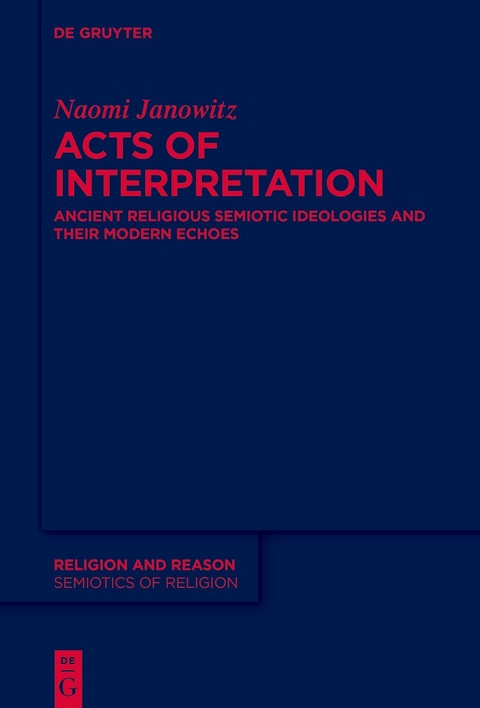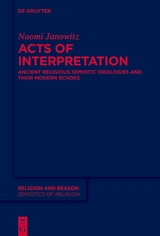Acts of Interpretation
Ancient Religious Semiotic Ideologies and Their Modern Echoes
Seiten
2022
De Gruyter (Verlag)
978-3-11-076859-6 (ISBN)
De Gruyter (Verlag)
978-3-11-076859-6 (ISBN)
Sinceits founding by Jacques Waardenburg in 1971, Religion and Reason has been a leading forum for contributions on theories, theoretical issues and agendas related to the phenomenon and the study of religion. Topics include (among others) category formation, comparison, ethnophilosophy, hermeneutics, methodology, myth, phenomenology, philosophy of science, scientific atheism, structuralism, and theories of religion. From time to time the series publishes volumes that map the state of the art and the history of the discipline.
Ancient authors debated proper verbal and non-verbal signs as representations of divinity. These understanding of signs were based on ideas drawn from language and thus limited due to a their partial understanding of the multi-functionality of signs. Charles S. Peirce’s semiotics, as adapted by anthropological linguists including Michael Silverstein, better explains the contextual linkages ("performativity") of ancient religious signs such as divine names. Sign meaning is always dependent on processes of interpretation and is always open to reinterpretation. Focusing on these processes permits a more detailed analysis of the ancient evidence. Examples are drawn from ancient Israelite verbal and non-verbal divine representation, the apostle Paul’s linguistic letter/spirit model, Christian debates about the limits of language to best represent the deity, Josephus’ aniconic advertisement of Jewish rites, the multi-layered divine representations in the Dura-Europos synagogue, the diverse "performativity" of Jewish ascent liturgies, and—the single modern example—the role of art at Burning Man. Divine representation is the basis for ritual efficacy even as sign meaning is a constant source of contention.
Ancient authors debated proper verbal and non-verbal signs as representations of divinity. These understanding of signs were based on ideas drawn from language and thus limited due to a their partial understanding of the multi-functionality of signs. Charles S. Peirce’s semiotics, as adapted by anthropological linguists including Michael Silverstein, better explains the contextual linkages ("performativity") of ancient religious signs such as divine names. Sign meaning is always dependent on processes of interpretation and is always open to reinterpretation. Focusing on these processes permits a more detailed analysis of the ancient evidence. Examples are drawn from ancient Israelite verbal and non-verbal divine representation, the apostle Paul’s linguistic letter/spirit model, Christian debates about the limits of language to best represent the deity, Josephus’ aniconic advertisement of Jewish rites, the multi-layered divine representations in the Dura-Europos synagogue, the diverse "performativity" of Jewish ascent liturgies, and—the single modern example—the role of art at Burning Man. Divine representation is the basis for ritual efficacy even as sign meaning is a constant source of contention.
Naomi Janowitz, University of California, Davis CA, U.S.A.
| Erscheinungsdatum | 21.04.2022 |
|---|---|
| Reihe/Serie | Religion and Reason ; 66 | Semiotics of Religion ; 7 |
| Zusatzinfo | 3 b/w tbl. |
| Verlagsort | Berlin/Boston |
| Sprache | englisch |
| Maße | 155 x 230 mm |
| Gewicht | 375 g |
| Themenwelt | Geisteswissenschaften ► Religion / Theologie |
| Geisteswissenschaften ► Sprach- / Literaturwissenschaft ► Sprachwissenschaft | |
| Schlagworte | Auslegung • Interpretation • Ritual • Semiotics • Semiotik |
| ISBN-10 | 3-11-076859-3 / 3110768593 |
| ISBN-13 | 978-3-11-076859-6 / 9783110768596 |
| Zustand | Neuware |
| Haben Sie eine Frage zum Produkt? |
Mehr entdecken
aus dem Bereich
aus dem Bereich
Das umfassende Standardwerk auf der Grundlage der aktuellen amtlichen …
Buch | Hardcover (2024)
Duden (Cornelsen Verlag)
CHF 48,95




